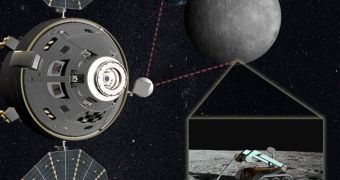A group of scientists at NASA is strongly considering the possibility of constructing what they refer to as a waypoint tended by humans on the far side of the Moon. This structure would serve as a relay and resupply base for space missions probing deeper within the solar system.
Top NASA officials say that the construction of such an installation would allow robotic spacecraft to go farther and faster than ever before, while at the same time resupply outgoing vehicles. Furthermore, the structure would provide a base of operations for robots being deployed on the far side of the Moon.
The fact that radio contact cannot be established with spacecraft located on the other side of Earth's natural satellite is very well known. However, a flying base located behind the Moon could easily pick up signals from Mission Control, and then retransmit them to their respective targets.
Constructing such an advanced machine would require international participation and cooperation, as well as the involvement of numerous universities and research centers around the world. The memo proposing this plan was circulated on February 3.
It was compiled by the NASA Human Exploration and Operations Directorate's Associate Administrator William Gerstenmaier. He says that the large spacecraft may be located on the Earth-Moon Lagrangian point 2 (L2), Space reports.
There are five Lagrangian points scattered around each celestial body's orbit. They are basically spots where the gravitational pulls of large, nearby cosmic objects roughly balance each other out, allowing a spacecraft to literally park at that location.
These spots are excellent for astronomical observations, which is why they are currently used by nearly all major space telescopes. The L2 point allows a satellite to remain in the same relative position with respect to the Sun-Moon-Earth system.
The NASA memo calls for the use of the newly proposed Space Launch System (SLS), as the main delivery system and the Orion Multi-Purpose Crew Vehicle (MPCV) as the manned spacecraft.
This capability-driven architecture could be used to successfully construct a flying base at L2, on the far side of the Moon. A full study meant to analyze the challenges facing the endeavor is scheduled to be completed on March 30, 2012.

 14 DAY TRIAL //
14 DAY TRIAL //